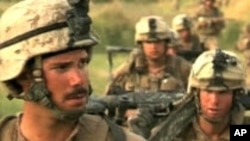As the situation in Afghanistan grows more deadly and complex, the Obama administration finds itself confronted with difficult questions over strategy and policy. Comparisons between the Afghan war's bid to defeat the Taliban and the 1960s war to defeat the communist backed insurgency in Vietnam have become frequent, especially regarding the growing U.S. military presence.
With 68,000 American troops due in Afghanistan by the end of this year, the current mission in Afghanistan is being increasingly compared to the U.S. involvement decades ago in Vietnam.
"What I found being in Afghanistan was all too familiar of problems not only in Iraq, but in Vietnam years ago. We are fighting a war a half a century later that we lost for similar reasons a half a century earlier," said Anthony Cordesman, who with the Center for Strategic and International Studies.
In Afghanistan the U.S. and NATO allies are fighting the black-turbaned Taliban in much the same way as American troops fought black-clad Viet Cong guerrillas some 40 years ago.
Some of the weaponry is similar. But while uniforms and equipment have evolved, the basic tactic of searching out an elusive enemy who melts into the population remains the same.
Retired Army Colonel Larry Wilkerson is a Vietnam veteran who became chief of staff to Colin Powell, a secretary of state under President George W. Bush. He says the parallels between the two conflicts are strong, especially in terms of corrupt governments in Saigon then and Kabul now.
"I see the same thing developing in Kabul. I see a corrupt leader. I see a leader who has as a vice president one of the most corrupt men, [Muhammad Qasim] Fahim, in Afghanistan, probably," said Wilkerson. "I see a leader who may have even orchestrated or tried to orchestrate his own supermajority in the current elections through fraud and abuse. I see a real problem."
President Obama is considering a request for more troops by his commander in Afghanistan, General Stanley McChrystal. What used to be called an escalation is called a troop surge today.
The biggest similarity is the issue of sanctuaries. The Taliban flee across the border into Pakistan, where U.S. troops cannot pursue them. Pakistan's efforts to clear them out have been ineffective, analysts say.
President Obama cannot invade Pakistan for diplomatic and political reasons, but he has continued unmanned drone attacks on Taliban hideouts.
Viet Cong fighters in the 1960s and 1970s took refuge and ran supplies from Cambodia and Laos into Vietnam. President Nixon bombed the border areas and invaded Cambodia in a bid to clean out the sanctuaries.
American troop strength in then-South Vietnam went from 184,000 at the end of 1965 to more than 500,000 by the end of 1968.
The United States had conscription during the Vietnam War, and that fueled massive antiwar protests.
Today the U.S. has an all-volunteer armed force, and that, analysts say, is the reason there have not been large anti war demonstrations.
But Michael O'Hanlon of the Brookings Institution says public skepticism about the Afghan effort is increasing, even in the president's own party.
"I know the American public's support for this war is declining," he said. "People have a lot of questions whether we should be in Afghanistan, whether it's becoming the next Vietnam."
More than 58,000 American servicemen were killed in Vietnam. Fewer than 1,000 American troops have died in Afghanistan - so far.








